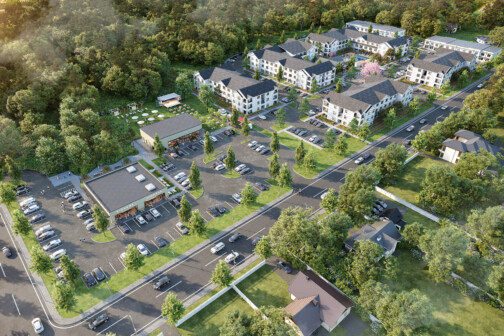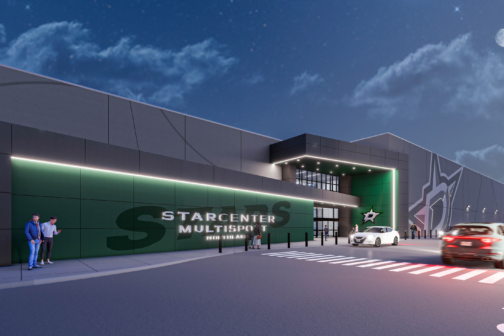In today’s economy, businesses of all sizes see the need to re-evaluate their supply chain strategies to remain agile and meet distribution demands. Two key factors are required for success: resiliency and preparation.

Businesses are transitioning from a just-in-time inventory model to a just-in-case model and they’re also increasingly focused on near-sourcing – the process of sourcing materials close to where they’re manufactured and closer to demand nodes and end-users. Expect this for the production of semiconductors and other technology components, as well as automobiles and parts, medical supplies, and pharmaceuticals.
These shifting supply chain strategies influence occupiers’ approach to industrial real estate. They’re taking on larger real estate footprints at the same time that industrial vacancy rates are the lowest ever. This in turn means rising rental rates for tenants.
Factors influencing today’s supply chain decisions
Several factors are compelling organizations to review their current supply chain strategies:
- The acceleration of e-commerce: Though the U.S. was slower to adopt e-commerce than Europe and Asia, e-commerce sales exploded at the onset of COVID-19 rising to 21.6% of total retail sales in mid-2020. They’re still above pre-pandemic levels at 20%, according to CBRE research. With consumers continuing to buy more goods online, e-commerce will continue to expand this year and in years to come.
- Continued outsourcing to third-party logistics companies (3PLs): In an effort to mitigate space and labor challenges, more businesses are outsourcing their supply chain to 3PLs. In fact, 3PLs were the most active lessors in 2021, nearly doubling their leasing volume to 121M SF, according to CBRE.
Though 3PLs try to make their leases coterminous with their customer contract terms this is becoming harder for them to achieve. Many industrial landlords are now demanding 10-year minimum lease terms and many 3PLs are assuming that risk. To that end, 3PLs provide their customers with a shorter-term lease despite market conditions.
- Pandemic-related supply chain disruption: The pandemic shined a spotlight on the risks of global supply chains from sourcing materials to manufacturing them abroad. A great example is the chip shortage we’ve all heard so much about.
The average wait time for materials used in the manufacturing process was a month longer in March 2022 than it was in March 2021, according to the Institute for Supply Management’s latest survey. Organizations today are near-sourcing as well as diversifying their suppliers while holding more inventory.
- Labor shortages (port workers and truckers): RBC Capital Markets reports that 77% of the world’s 22 largest ports are currently experiencing delays related to labor shortages.
- Transportation costs: Freight costs and tariffs have increased substantially due to fuel prices, inflation and the Ukraine conflict. The cost to ship goods via ocean freight increased more than 200% in 2021 and the cost for domestic freight increased over 40%, according to Drewry Supply Chain Advisors and the Cass Freight Index.
Transportation costs typically account for 50 to 70% of a company’s total logistics spend, according to a CBRE Supply Chain Advisory while fixed costs (including real estate) account for only 3 to 6%. It takes roughly an 8% increase in fixed costs to equal the impact of just a 1% increase in transportation costs.
Tightest industrial real estate market
In most primary and secondary markets, developers can rarely build industrial products to accommodate demand. Last year, occupiers leased an unprecedented amount of industrial space with net absorption exceeding expectations at more than 496M SF, according to JLL reports. For the first time in history, industrial vacancy dropped below 4% with 2021 ending with a vacancy rate of 3.8%.
Rents also continue to trend upward with average asking rents reaching $7.11/SF at year-end 2021, an increase of 11.3% YOY. Demand isn’t the only contributing factor to rental increases today; 30% higher construction costs are also fueling the fire. At the same time, many landlords are demanding 4% annual rental bumps due to rising inflating pressure.
While rates increase nationwide, certain markets feel it more than others. New Jersey and California see the highest rents. Any company facing a renewal in the next 36 months is likely facing a 50 to 100% increase in these markets.
Ultimately, these increased costs are passed through to the consumer. But, as long as consumer demand remains strong, companies can continue to absorb the higher cost with incremental increases in their goods.
Developers completed nearly 304M SF of new industrial space throughout 2021, according to JLL. Despite ending 2021 with more than 467M SF under construction – a 70% increase from year-end 2020 – there’s no risk of overbuilding.
Most buildings slated for spec development are leased before completion. Nearly two-thirds of the product delivered in 2021 was preleased, up from 45% in 2020 and 50% in 2019, JLL reports.
Though occupiers shouldn’t take on more space than they need, they need to understand their space needs for at least the next three years especially with industrial real estate hard to come by, not to mention pricey.
By preparing and leveraging data analytics, industrial occupiers can act when the timing is right and the ideal real estate opportunity presents itself.
Bob Mohr is the founder and chairman of Mohr Capital.





